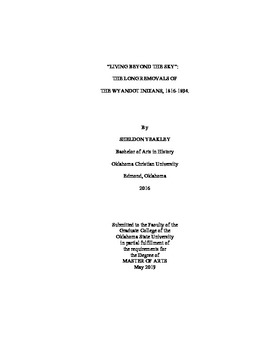| dc.contributor.advisor | Miller, Douglas K. | |
| dc.contributor.author | Yeakley, Sheldon | |
| dc.date.accessioned | 2019-10-25T20:25:27Z | |
| dc.date.available | 2019-10-25T20:25:27Z | |
| dc.date.issued | 2019-05-01 | |
| dc.identifier.uri | https://hdl.handle.net/11244/321624 | |
| dc.description.abstract | In 1816, the Wyandot Indians lived and claimed title to much of the contested Ohio country. By 1894, after a series of removals, they resided in northeastern Indian Territory on a reservation of twenty-thousand acres. The long and repeated process of this forced migration and dispossession reshapes the historical understanding of Indian Removal alongside several key components of Native American history from Indian slave-holding, citizenship, to identity. | |
| dc.description.abstract | The Wyandot's first removal from Ohio to Kansas Territory reflects the coercive tactics the U.S. used to force Indian land cessions. The Wyandot were not unique in the forced nature of their removal, but the presence of an influential Methodist mission both characterized the intra-tribal debate, which the Wyandot held over the prospects of removal, and shaped the opinions of prominent U.S. officials. After removing to Kansas Territory, the Wyandot entered a land bordering a slave society. Interestingly, within three years a select few prominent Wyandot began practicing and promoting slavery. In the decades leading up to the Civil War, the Wyandot like the U.S., engaged in a public and heated debate over the value and morality of slavery. Splitting their church along pro-South and pro-North lines the Wyandot became active members in the national and regional political conflict of Bleeding Kansas. Finally, in 1867 the Wyandot signed their last removal treaty which transplanted them to their current lands in Oklahoma. This treaty, and its predecessor in 1855, are intriguing and unique examples of the legalistic removal of Indian rights. Reshaping the historiographical portrayal of Native American land-holding and citizenship, some Wyandot in 1855 had been granted individual allotments and U.S. citizenship. In 1867, this was revoked, proving that for the U.S. assimilation was not the end goal, rather it was removal. | |
| dc.description.abstract | Wyandot removals are a unique history which shares elements with all Indian Removals. The overarching presence of the U.S.'s intention to remove the Wyandot of their lands and rights is undeniable. What remains is an unbroken history of Wyandot active participation in their own historical circumstances and the consistent practice of Wyandot sovereignty. | |
| dc.format | application/pdf | |
| dc.language | en_US | |
| dc.rights | Copyright is held by the author who has granted the Oklahoma State University Library the non-exclusive right to share this material in its institutional repository. Contact Digital Library Services at lib-dls@okstate.edu or 405-744-9161 for the permission policy on the use, reproduction or distribution of this material. | |
| dc.title | "Living Beyond the Sky": The Long Removals of the Wyandot Indians, 1816-1894 | |
| dc.contributor.committeeMember | Boles, Richard J. | |
| dc.contributor.committeeMember | Schauer, Matthew | |
| osu.filename | Yeakley_okstate_0664M_16193.pdf | |
| osu.accesstype | Open Access | |
| dc.type.genre | Thesis | |
| dc.type.material | Text | |
| dc.subject.keywords | indian removal | |
| dc.subject.keywords | kansas city | |
| dc.subject.keywords | ohio indians | |
| dc.subject.keywords | william walker jr. | |
| dc.subject.keywords | wyandot indians | |
| dc.subject.keywords | wyandotte | |
| thesis.degree.discipline | History | |
| thesis.degree.grantor | Oklahoma State University | |
